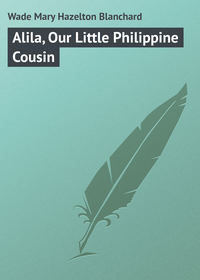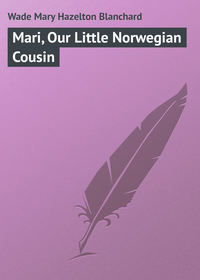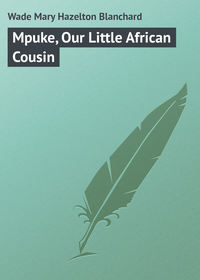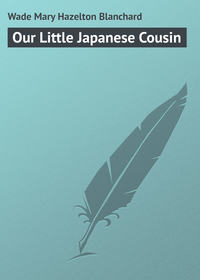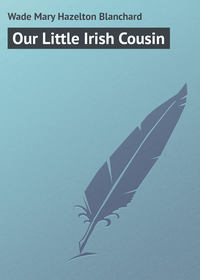 полная версия
полная версияYellow Thunder, Our Little Indian Cousin
There are many other good spirits. The red boy feels their presence in the forests and out upon the waters. They are ever around him to protect him when he is good. But, if he should be bad? Ah! There are many evil spirits, too, who are only too ready to work mischief and harm among men, if they have the chance.
Yellow Thunder believes that animals have souls, only they are not as wise as men. Sometimes, when they have done great wrongs, men have been changed into animals. Our cousin thinks the wolf was once a little boy like himself, but the poor little fellow was neglected by his parents, and was transformed into an animal. The raccoon was once a shell on the seashore. What curious ideas these are! Where do you suppose they came from before they lived in the minds of the red race?
While we are speaking of these things, I will stop and tell you of something that happened at Yellow Thunder's house the other day. His father, Black Cloud, came home from the hunt bringing a big black bear. It was so heavy that two other men had to help in carrying it. They had discovered the creature in a hollow tree and had easily killed it. But now comes the amusing part of the story. As soon as the bear was laid down in front of the hut, Yellow Thunder and his mamma went up to it and began to kiss and stroke the dead animal's head. Black Cloud did the same, and then they all begged the bear's pardon for having killed it. Black Cloud said, "I would not have done so, had we not needed food, so I know you will forgive me."
Then the head of the bear was cut off and laid on one of the best mats. It was decorated with all the jewelry owned by the family. There were silver armlets and bracelets, as well as belts and necklaces of wampum. Tobacco was placed in front of its head, while each one in turn lighted a pipe and blew the smoke into the bear's nostrils. This was to turn away its anger from those who had killed it. Black Cloud then made a speech to the bear.
I suppose these people believed that the spirit of some human being had come to live in the animal's body, and they looked upon it as a friend whom they were forced to kill.
After all this ceremony, the fat of the bear was boiled down to oil, the meat was cut up and dried for future use, while the head was put into the pot to cook for dinner. I do not doubt that when the bear stew was served, Yellow Thunder did not give a single thought to the idea of eating a friend. He had done his duty in asking its forgiveness, and that was enough.
What kind of a school does Yellow Thunder attend? It is a very large one. It covers the forests, the rivers, and the lakes. And who is his teacher? The very same one who gives so many lessons to Anahei in the hot land of Borneo, so far away. Dame Nature is her name. She is usually loving and kind, but sometimes she shows her anger in the storms and winds which rage about our little cousins.
The lessons which Yellow Thunder learns are very different from those given Anahei, for they live in vastly different climates. Anahei, you remember, is near the equator, while Yellow Thunder lives in the temperate lands. He learns from the ice and the snow, he sees different animals, plants, and trees.
He is quicker, stronger, and brighter than Anahei, for the cold winters make him so. His eyes are very sharp, his ears will hear sounds that yours would not notice, his feet can travel many miles without his having a thought of being tired.
He has no compass, and yet he can journey in the forest in any direction he may choose without losing his way. How does he do it? He has learned to notice that the tops of the pine-trees generally lean toward the rising sun. He has discovered that moss grows toward the roots of the trees on their north side, while the largest branches of trees are usually found on the south side of their trunks.
In fact, Yellow Thunder has learned so many of Nature's secrets that, if he should reveal them all, they would fill many books.
This cousin of yours knows nothing about writing as you understand it. He puts all his stories into pictures. He could send you a letter with two or three pictures, telling a long, long story, but I don't believe you could understand one-quarter of it. His little Indian friends would be able to read it all at a glance.
Their eyes are well trained, although they know nothing about your alphabet or vertical penmanship.
Black Cloud often finds a bark picture hanging to some tree while he is hunting. It is better than any guide-post such as we make, because it will tell him so much. He will know from it that other red men have journeyed this way, and what kind of experience they had. Perhaps it will warn him of danger, or explain to him the best direction to go if he wishes to find more game.
You may like to see such a picture. I will copy one which Mr. Henry Rowe Schoolcraft saw while he was living among the Indians. He was exploring the country with a party of white men and two Indian guides. They lost their way during the day and camped out all night in a deep forest. Before they went away on the next morning, the Indian guides hung this picture on a tree:
They thought it might be of use to others passing there.
Figure I. is the officer who commanded the party. You may know this because he carries a sword. II. has a book in his hand. This shows he is the secretary. III. carries a hammer, because he is a geologist. IV. and V. are attendants. VI. is the man who interprets to the party the words of the Indian guides. The group of eight figures marked IX. consists of soldiers. Their muskets stand in the corner, and are marked X., VII. and VIII. are the two Indian guides. You will notice that they are drawn with no hats, which shows at once that they are not white men. XIII., XIV., and XV. represent fires, showing that each separate group – officers, soldiers, and Indian guides – had a separate one. Figures XI. and XII. are the pictures of a prairie-hen and a tortoise, which were the only game they had been able to kill that day. The pole to which the piece of bark was fastened leaned in the direction which the party was going to travel. There were three notches in the pole to show the distance they had already journeyed.
Yellow Thunder learns to read these bark pictures, and also to make them himself. He enjoys this work very much, and can tell a long story quickly. If I were you, I would write him a letter and ask him to answer it in his own way.
This cousin of yours has many things to keep him busy. I have already told you of the mats and baskets which he helps his mother in making. He goes with her to get the bark which she will use in mending the wigwam and making many useful things.
He makes barrels out of red elm bark in which to store groundnuts, corn, and beans. He cuts ladles out of wood, which the family will use in eating their soup and hominy. On the end of each ladle Yellow Thunder carves the figure of some animal. Perhaps it is a beaver or a squirrel. He does it very neatly. Whatever the Indian boy does, he does well.
Yellow Thunder makes sieve-baskets out of splint. His mother can sift the corn-meal through one of these as nicely as your mamma can do it with her wire sieve.
He makes salt-bottles out of corn-husks, wooden bowls and pitchers, and many other things for the simple housekeeping. All this work is done during the cold winter months, while his mother is making moccasins and kilts for his father and himself.
When spring opens, she must till the ground for her corn, and Yellow Thunder can now be of great help. She will miss him greatly when he begins to hunt with his father. She will then have all this work to do alone.
I wish you could see the Indian woman's garden. It is kept so carefully, I don't believe you would be able to find a weed. Yellow Thunder's mother did a queer thing the first night after it was planted. She stole out of the wigwam alone into the darkness. She went behind a bush, and took off all her clothing. Taking her skirt in her hand, she ran swiftly around the field of corn, dragging the garment after her. She believed this would keep away all insects which might destroy the crop, and that now it would be sure to yield well. For what a sad thing it would be if winter should come with no bread to eat through the long months!
Yellow Thunder is very fond of his mother's corn bread. The corn is first hulled by boiling in ashes and water. The tough skin will now slip off easily. After being washed and dried, it is pounded in a mortar into flour. Then it is sifted and made into cakes about an inch thick. These cakes are dropped into boiling water, and are quickly made ready for our red cousin to eat. Since he was a baby, he has lived almost entirely on corn bread, together with the game and fish which his father brings home.
Yellow Thunder eats something on his corn cakes which you like as much as he does himself. It is maple syrup. The sugar which his mother makes from it is the only kind he has ever tasted in his life. It is his work to tap the trees in the spring, and bring home the jars of sap, which his mother will boil down to syrup and sugar.
When her husband goes out on a long hunt, he must take food with him, as it may be a long time before he gets any game. He cannot carry the boiled corn cakes, as they would soon crumble and grow sour. His good wife roasts some corn until it is quite dry. She pounds it into powder and mixes it with maple sugar. It is packed away in Black Cloud's bearskin pocket. He need not worry about hunger now, even if he is away from home many days. He has everything he needs to keep hunger away.
Yellow Thunder is very proud of the beautiful canoe he has just finished. He had to search a long time before he was able to find a tree which suited him. He wanted to make his canoe of birch bark because it is much lighter than the bark of the elm-tree, of which his father's boat is made.
He needed a strip at least twelve feet long, because the canoe must be made of one piece. Two of his boy friends went with him and they at last obtained a strip which was just right. They helped him bend it into shape, until the side pieces came together in two pointed ends. How do you suppose they fastened the edges together? They made thread out of the bark itself, and with this Yellow Thunder sewed the pieces together.
He next got strips of white ash for the rim of his canoe, because the wood of that tree is very elastic. The boat must be made stronger still with ribs of the ash, and the work is done.
The canoe is a little beauty. It is so light that the red boy can lift it out of the water and carry it with the greatest ease from place to place. I wish you could see him as he shoots down the river in his boat. He moves so rapidly, he will be out of sight in a few minutes.
The Indians of the northwestern part of our country used to make their canoes of cedar logs. The cedar trees there grow so large that canoes eighty feet long, and large enough to hold one hundred men, were made of a single piece. One was exhibited at the Columbian Exposition at Chicago. It was twelve feet wide.
Yellow Thunder has taken his bow and arrows with him to-day, as he may come upon a flock of wild ducks. He would like to surprise his mother with some birds for supper.
He can shoot well. He will not fail to secure some game. He has practised archery ever since he was a tiny little fellow. He would feel himself disgraced for ever if he should disappoint his father when they go out to hunt.
I can't tell you how many bows and arrows he has already made in his lifetime. He has now grown so large and strong that he uses a bow three and a half feet long. It has such a difficult spring that I fear you could not bend it far, but Yellow Thunder can set his arrow to the head with ease. But it takes skill and great strength to do it.
Perhaps you wonder why the arrow is feathered at the end. This will make it go straight ahead in the direction in which it is sent. Sometimes Yellow Thunder uses arrow-heads cut out of flint. They are dangerous things, and will kill deer and even men. Indians have often been known to place poison on the arrow-heads they used in warfare. The agonies of the men who were shot by them were terrible indeed.
Black Cloud has not been to war since Yellow Thunder was born. There are so few of the red race now, and the numbers of the white men are so great, that there is not much chance of warfare.
However, many stories are told in Black Cloud's lodge of the good old days when the war-whoop was commonly heard and the tomahawk and scalping-knife were in constant use. Yellow Thunder often passes by the grave of a great Indian chief, and thinks about that hero's bravery in battle. This grave is reverently marked and carefully fenced in. The boy wishes he had a chance to leave such a memory.
At the head of the grave there is a stick with the figure of a wolf carved upon it. It is the symbol, or "totem" of the chief's tribe. Below the wolf there are many strokes of red paint, which Yellow Thunder likes to count, for each stroke tells of a scalp taken in warfare.
Not many miles up the river above Yellow Thunder's home, beavers are hunted. Black Cloud likes to catch them, because their flesh is good to eat, and the skin is covered with fine fur. Last winter he allowed his son to go with himself and a party of men to hunt for this clever little creature.
Yellow Thunder believes that the beavers were once people and able to speak like himself. But they were too wise, so the Great Spirit took away this power and changed them into these animals.
I wonder if you have ever seen a beaver's house. He usually makes it of the young wood of birch or pine trees, and builds it a short way out in the river, so that it is surrounded by water. He shows a great deal of skill in making his home. It has a roof shaped like a dome. It reaches three or four feet above the surface of the water.
There are generally only two young beavers in the family. The first year they live with their parents. The second year they have a room built next to the main house for their special use. By this time they are old enough to help their father and mother get food. They eat great quantities of roots and wood, but they like the wood of the birch and poplar trees best of all.
When the young beavers are two years old, they leave their old home, and choose a new place in which to build houses for themselves. Once in a great while, hunters find beavers that the Indians call "old bachelors." This is because they live alone, build no houses, but make their homes in holes they find, or dig out for themselves.
The beaver always makes holes in the banks of the river near his house. The entrance to such a hole is below the surface of the water, so that if the beaver is attacked in his house, he can flee for safety to his hiding-place in the bank.
Now let us return to Yellow Thunder and his beaver hunt. It was a bitter cold day and the river was frozen over in some places, but that would be so much the better if the hunters hoped to secure their game. They journeyed by the riverside for several miles. There was a heavy fall of snow, but they moved along quickly with the help of their snowshoes, till one of the men whispered: "I see it. Stop!"
Sure enough! A few feet away from them and from the bank rose the roof of a dam above the ice. One of the men tried the ice and found it was thick enough to bear them.
Yellow Thunder was told to remain where he was on the bank, while the rest of the party took heavy tools in their hands and went over to the beavers' house. They quickly destroyed it. But the beavers? What had become of them? They did not stay in their house to have it broken down over their heads. They were too wise. When the first alarm was given, they hurried through the water, under the icy covering of the river, to a hiding-place in the bank. They had made it long ago to be ready in case of danger.
Would the Indians succeed in finding them? Remember that nothing could be seen to show where the beavers had gone. The hunters crept along the ice on the edges of the river, and kept striking it with their mallets. If they should hear a hollow sound as they struck the ice, they would know they had discovered the beavers' hiding-place.
Ah! sure enough! It is Yellow Thunder himself who says: "Quick, father, come here; I have found it. I know this is a hole because of the noise the water makes underneath. Beavers are breathing there, or it would not move so quickly."
Black Cloud hurries to the spot and the ice is cracked in an instant. Yes, his son is right. A family of beavers is inside the hole. They must be taken quickly, or they will escape. There is but one way to do it. The hunter must reach his hands into the hole and pull the animals out. Their teeth are very sharp, and they will do their best to bite him, but Black Cloud does not think of that. He is quickly at work and pulls out one after another.
There are four beavers in all, – two old ones and their young about two years of age. They are soon killed and ready to be skinned. How beautiful and glossy the fur is! It is at its very best in midwinter.
This has been a fine day's sport, and Black Cloud has received only one bad bite in his wrist. It must cause him a good deal of pain, yet he does not show that he feels any. He binds up his wrist, and nothing is said about it.
When they reach home Yellow Thunder's mamma will take the tails of the beavers and put them in the pot to boil. The Indians think they are a great delicacy. They will make a feast, to which Black Cloud has gone to invite his friends.
His wife is standing in the door of the wigwam, waiting for the return of her husband and son. She has dressed herself with great care to-day, and has a really beautiful costume. Just imagine your mamma in a dress like hers. She wears long leggings of red cloth reaching from above her knees down over her moccasins. They are worked with beads around the edges.
A long time ago the Indian women made their clothing of deerskins and embroidered them with porcupine quills, but nowadays they buy cloth and beads of the white traders in exchange for furs.
Over the woman's leggings a long blue skirt reaches from her waist nearly to the ground. This, also, is embroidered with beads in a flower pattern. And last, but not least, she wears a bright calico overdress which reaches from her throat to a short distance below her waist, is also beaded, and is gathered in at the belt.
I must not forget to mention her glass necklace, large silver earrings, and the shoulder ornaments of woven grass and beadwork.
She is a graceful woman, and it is pleasant to look at her with the sunset light upon her black hair and eyes.
When her little boy was six years old he was very sick. His cheeks burned with fever. He could not lift his head from the mat on which he lay. His dear mamma scarcely left his side through the long hours of the day. She tried to soothe him with low, sweet songs, but it was in vain. The fever grew stronger and fiercer. Black Cloud came home at night. Looking at his little son, he said, "The medicine-man must come. He will cure him."
The medicine-man was at once sent for. He is a very important person among the Indians. He is considered very wise. He is thought to have wonderful dreams and to get instruction from the Great Spirit. The red people think he can cure sickness, unless it is the will of the Great Spirit for the patient to die.
The medicine-man always carries a bag of charms to help him in making his cures. I do not doubt you would laugh at the collection in the bag, if you had a chance to peep in, but no good Indian has a thought of doing such a thing. It is believed to be holy, and nothing inside should be looked upon except as the medicine-man draws it out to work his cures.
There are medicines, the carved figures of different animals, the bones of others, and I don't know how many other queer things.
Poor little Yellow Thunder looked up with delight as the great man entered the hut. He believed that he would soon be well and ready to work and play once more.
The medicine-man ordered first that a dog be sacrificed. Next, that the family prepare a great feast for themselves. These things would help to satisfy the Great Spirit and turn away his anger. But this was not all. He took out a rattle from his bag. It was made of the dried hoofs of deer fastened to a stick. He began to sing, beating time with his rattle, and striking himself violent blows. The singing grew louder and louder. The rattle made a fearful din.
How did our poor sick cousin stand it? I'm sure I can't tell. The little fellow lay with closed eyes and hardly moved. This queer doctor at length stopped his song and got ready to go away. He told Yellow Thunder's papa that his son would be sure to get well. And you know already from my story that our red cousin did get over his sickness, and grew to be a big, strong boy. Whether the treatment he got was any help, or whether Mother Nature did all the work, I leave you to decide for yourselves. I have my own opinion in the matter.
Yellow Thunder is very fond of music. I wonder what he would think of a church organ or grand piano. His own instruments are very simple. He made them himself. He has a tambourine on which he often plays in the evening while other children dance. He cut a section of wood from a hollow tree and stretched a skin over it, and his instrument was made.
He also has a flute. It was a little more work for the red boy to make this. He carved two pieces of cedar in the shape of half cylinders, and fastened them together with fish glue. He next hunted about in the woods for a snake. After he had found one and killed it, he took off the skin and stretched it over the wood. Eight holes were then made in the instrument, as well as a mouthpiece like that of a flageolet.
When Yellow Thunder blows upon this flute, it makes soft and sweet music. It lay by his side when he was sick with the fever, and as soon as he was strong enough to sit up, he amused himself by playing some simple tunes his mamma had taught him.
Our little friend is very fond of dancing. His people have so many dances that I shall have to tell you about some of them.
They believe the Great Spirit gave them the gift of dancing. They have a Dance for the Dead, a Medicine Dance, the War-dance, the Dance of Honour, and I don't know how many others. In some of them only men take part, and they have special costumes, while in others there are none but women. It seems as though there were always something happening among the Indians to give them a good reason to dance.
The War-dance is only performed in the evening and always on some important occasion.
Fifteen or twenty men are usually chosen, one of whom must be the leader. All appear in costume and wear knee rattles of deer's hoofs. When the time draws near, the people gather in the council-house and wait quietly for the dancers to arrive. A keeper-of-the-faith rises and makes a short speech on the meaning of the dance. Hark! The war-whoop sounds outside! It is heard again, and still again. The band is drawing near. Ah! here they come at last.
To our eyes they look hideous in their war-paint and feathers, but to the crowd of eager Indians who are waiting, they appear very fair, indeed.
They march in and form a circle. The war-whoop is sounded again by the leader, and answered by the rest of the dancers. At a given sign, the singers commence the war-song, the drums beat, and the dancers begin to move. They come down on their heels again and again with the greatest force, keeping time to the beating of the drums. The knee rattles make noise enough of themselves. The din is fearful.
The dancers change their positions continually. At the same moment you will see some of them with their arms raised as though to attack, others in the act of drawing the bow, others again appear to be throwing the tomahawk, or striking with the war-club. Every position possible in battle is taken.
Each one is full of the excitement of the moment. The wild music and dancing last for about two minutes. For the next two minutes the dancers walk around in a circle to the slow beating of the drums. Then there is another war-whoop, which is followed by another dance and song.
The dance is often stopped by a tap upon the ground by one of the audience. He wishes to make a short speech. It, maybe, is a funny one to make everybody laugh. Or perhaps the speaker wishes to inspire the people to nobler lives or to greater love for their race. He can say anything he chooses, on condition that at the end of the speech he makes a present to one of the dancers. This speech gives the dancers a chance to rest, and at the same time keeps the people interested.


